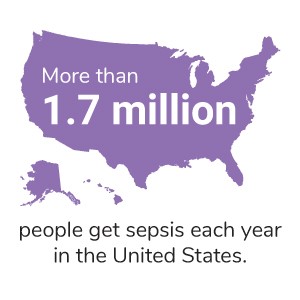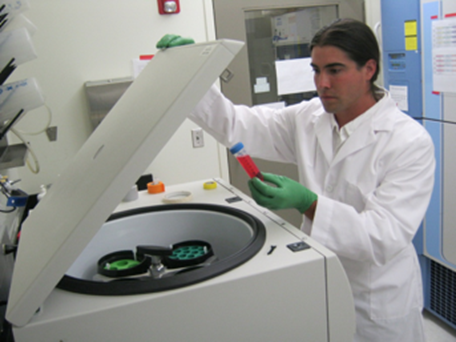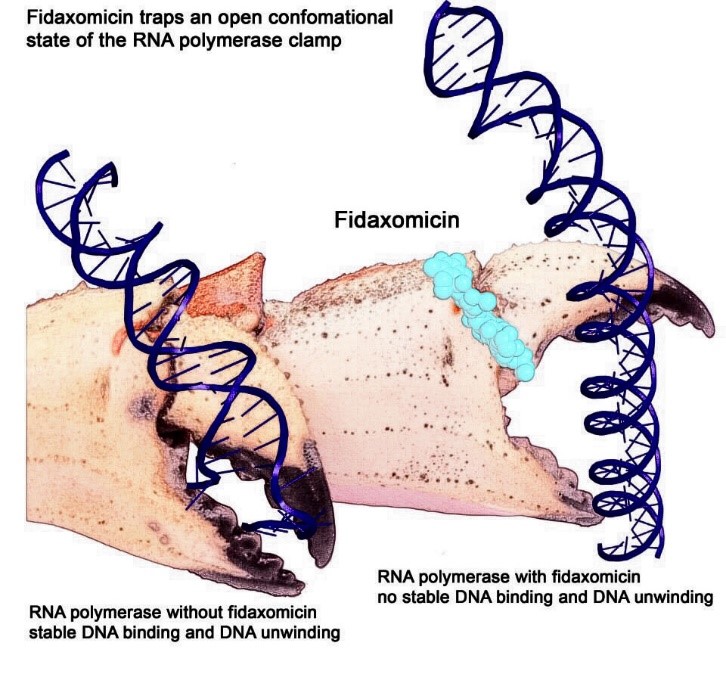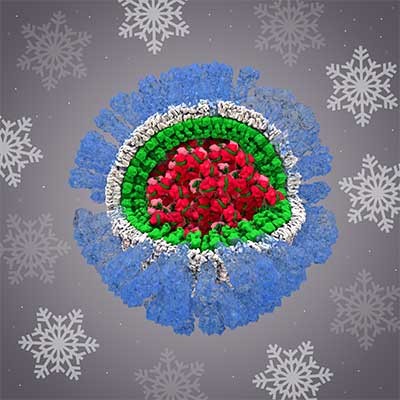Looking for more virtual learning opportunities? NIGMS recently recorded a series of 14 webinars where experts shared their knowledge on topics from infectious disease modeling to pursuing a career in biomedical science. With the start of the 2020-2021 academic year, we’re highlighting a webinar that’s particularly relevant for our Biomedical Beat readers who are educators. You can check out the whole series on the NIGMS YouTube channel.
Continue reading “Learn Directly From Scientists Through Available Webinar Series”Tag: Infectious Diseases
Sepsis: Using Big Data to Cut a Killer Down to Size
 View the full infographic for more facts about sepsis.
View the full infographic for more facts about sepsis.
Sepsis is a serious medical condition caused by an overwhelming response to infection that damages tissues and organs. It’s unpredictable, progresses quickly, can strike anyone, and is a leading cause of hospital-related deaths. In the U.S. alone, nearly 270,000 people die each year from sepsis. Those who survive sepsis often end up in the hospital again, and some have long-term health complications. Early treatment is key for many patients to survive sepsis, yet doctors can’t easily diagnose it because it’s so complex and each patient is different.
Despite decades of research, sepsis remains a poorly understood condition with limited diagnostic tools and treatment. To tackle these obstacles, scientists Vincent Liu, Christopher Seymour, and Hallie Prescott have started using a “big data” approach, which relies on complex computer programs to sift through huge amounts of information. In this case, the computers analyze data such as demographic information, vital signs, and routine blood tests in the electronic health records of sepsis patients. The goal is to find patterns in the data that might help doctors understand, predict, and treat sepsis more effectively.
Continue reading “Sepsis: Using Big Data to Cut a Killer Down to Size”On the RISE: Joshua and Caleb Marceau Use NIGMS Grant to Jump-Start Their Research Careers
A college degree was far from the minds of Joshua and Caleb Marceau growing up on a small farm on the Flathead Indian Reservation in rural northwestern Montana. Their world centered on powwows, tending cattle and chicken, fishing in streams, and working the 20-acre ranch their parents own. Despite their innate love of learning and science, the idea of applying to and paying for college seemed out of reach. Then, opportunities provided through NIGMS, mentors, and scholarships led them from a local tribal college to advanced degrees in biomedical science. Today, both Joshua and Caleb are Ph.D.-level scientists working to improve public health through the study of viruses.
Joshua Discovers Unexpected Opportunities
 Joshua Marceau at Salish Kootenai College, where he gained research experience as an undergraduate. Credit: Joshua Marceau.
Joshua Marceau at Salish Kootenai College, where he gained research experience as an undergraduate. Credit: Joshua Marceau.As the oldest of four brothers, Joshua was the trailblazer in the family. But like most trailblazers, his path to a scientific career wasn’t always smooth. He attended a reservation school until sixth grade, then was homeschooled. He earned his GED through the local tribal community college, Salish Kootenai College (SKC) in Pablo, so he could begin to take college-level chemistry.
Continue reading “On the RISE: Joshua and Caleb Marceau Use NIGMS Grant to Jump-Start Their Research Careers”RNA Polymerase: A Target for New Antibiotic Drugs?
DNA, with its double-helix shape, is the stuff of genes. But genes themselves are only “recipes” for protein molecules, which are molecules that do the real heavy lifting (or do much of the work) inside cells.
 Artist interpretation of RNAP grasping and unwinding a DNA double helix. Credit: Wei Lin and Richard H. Ebright.
Artist interpretation of RNAP grasping and unwinding a DNA double helix. Credit: Wei Lin and Richard H. Ebright.Here’s how it works. A molecular machine called RNA polymerase (RNAP) travels along DNA to find a place where a gene begins. RNAP uses a crab-claw-like structure to grasp and unwind the DNA double helix at that spot. RNAP then copies (“transcribes”) the gene into messenger RNA (mRNA), a molecule similar to DNA.
The mRNA molecule travels to one of the cell’s many protein-making factories (ribosomes), which use the mRNA message as instructions for making a specific protein.
Continue reading “RNA Polymerase: A Target for New Antibiotic Drugs?”PREP Scholar’s Passion for Understanding Body’s Defenses

Charmaine N. Nganje, PREP scholar at Tufts University in Boston.
Credit: Katherine Suarez.
Charmaine N. Nganje
Hometown: Montgomery Village, Maryland
Influential book : The Harry Potter series (not exactly influential, but they’re my favorite)
Favorite movie/TV show: The Pursuit of Happyness/The Flash
Languages: English (and a bit of Patois)
Unusual fact: I’m the biggest Philadelphia Eagles fan from Maryland that you’ll ever meet
Hobbies: Off-peak traveling
Q. Which NIGMS program are you involved with?
A. The Postbaccalaureate Research Education Program (PREP) ![]() at the Sackler School of Graduate Biomedical Sciences at Tufts University in Boston.
at the Sackler School of Graduate Biomedical Sciences at Tufts University in Boston.
Festive Flu Virus Structure

Credit: Rommie Amaro, Jacob Durrant, Adam Gardner, and colleagues.
Ah, December—a month suffused with light-filled holidays, presents, parties . . . and the spread of colds and flu. This playful image uses a festive approach to the serious science of understanding and finding ways to combat the flu virus.
Teens Explore Science and Health through Game Design
Educators often struggle to teach teens about sexual and reproductive health. Hexacago Health Academy (HHA) ![]() , an education program from the University of Chicago, leverages the fun activity of gameplay to impart these lessons to young people from Chicago’s South Side community. Funded by the Student Education Partnership Award (SEPA)
, an education program from the University of Chicago, leverages the fun activity of gameplay to impart these lessons to young people from Chicago’s South Side community. Funded by the Student Education Partnership Award (SEPA)![]() , part of the National Institute of General Medical Sciences (NIGMS), in 2015, HHA assists teachers in their goal of helping teen students gain awareness and control over their health and also learn about careers in STEM
, part of the National Institute of General Medical Sciences (NIGMS), in 2015, HHA assists teachers in their goal of helping teen students gain awareness and control over their health and also learn about careers in STEM ![]() and health fields.
and health fields.

Genesis of HHA
HHA was cofounded by Melissa Gilliam ![]() , a University of Chicago professor of Obstetrics/Gynecology and Pediatrics and founder of the Center for Interdisciplinary Inquiry & Innovation in Sexual and Reproductive Health (Ci3)
, a University of Chicago professor of Obstetrics/Gynecology and Pediatrics and founder of the Center for Interdisciplinary Inquiry & Innovation in Sexual and Reproductive Health (Ci3) ![]() . During a 2013 summer program with high school students, Gilliam and Patrick Jagoda
. During a 2013 summer program with high school students, Gilliam and Patrick Jagoda ![]() , associate professor of English and Cinema & Media Studies, and cofounder of Ci3’s Game Changer Chicago Design Lab, introduced the students to their STEM-based alternate reality game called The Source, in which a young woman crowdsources player help to solve a mystery that her father has created for her.
, associate professor of English and Cinema & Media Studies, and cofounder of Ci3’s Game Changer Chicago Design Lab, introduced the students to their STEM-based alternate reality game called The Source, in which a young woman crowdsources player help to solve a mystery that her father has created for her.
From their experience with The Source, Gilliam and Jagoda quickly learned that students not only wanted to play games but to design them too. What followed was the Game Changer Lab’s creation of the Hexacago game board, as well as the launch of HHA, a SEPA-funded project that the lab oversees.
Hexacago Game Board
At the core of HHA is the Hexacago game board, which displays the city of Chicago, along with Lake Michigan, a train line running through the city, and neighborhoods gridded into a hexagonal pattern.
HHA students not only play games designed from the Hexacago board template, but also design their own games from it that are intended to inspire behavior change in health-related situations and improve academic performance.

In this way, HHA is much more than just game design and play. “Students have no idea that what they’re doing is learning. In their minds, they’re really focused on designing games,” says Gilliam. “That’s the idea behind Hexacago Health Academy: helping people acquire deep knowledge of science and health issues by putting on the hat of a game designer.” Moreover, through the process of gameplay and design, students practice all the rich skills that result from teamwork, including collaborative learning, leadership, and communication.
Continue reading “Teens Explore Science and Health through Game Design”
Interview with a Scientist: Michael Summers, Using Nuclear Magnetic Resonance to Study HIV
For more than 30 years, NIGMS has supported the structural characterization of human immunodeficiency virus (HIV) enzymes and viral proteins. This support has been instrumental in the development of crucial drugs for antiretroviral therapy such as protease inhibitors. NIGMS continues to support further characterization of viral proteins as well as cellular and viral complexes. These complexes represent the fundamental interactions between the virus and its host target cell and, as such, represent potential new targets for therapeutic development.
In this third in a series of three video interviews with NIGMS-funded researchers probing the structure of HIV, Michael Summers,![]() professor of biochemistry at the University of Maryland, Baltimore County, discusses his use of nuclear magnetic resonance (NMR) technology to study HIV. Of recent interest to Summers has been using NMR to investigate how HIV’s RNA enables the virus to reproduce. His goals for this line of research are to develop treatments against HIV as well as learning how to best engineer viruses to deliver helpful therapies to individuals with a variety of diseases.
professor of biochemistry at the University of Maryland, Baltimore County, discusses his use of nuclear magnetic resonance (NMR) technology to study HIV. Of recent interest to Summers has been using NMR to investigate how HIV’s RNA enables the virus to reproduce. His goals for this line of research are to develop treatments against HIV as well as learning how to best engineer viruses to deliver helpful therapies to individuals with a variety of diseases.
Interview with a Scientist: Wes Sundquist, How the Host Immune System Fights HIV
For more than 30 years, NIGMS has supported the structural characterization of human immunodeficiency virus (HIV) enzymes and viral proteins. This support has been instrumental in the development of crucial drugs for antiretroviral therapy such as protease inhibitors. NIGMS continues to support further characterization of viral proteins as well as cellular and viral complexes. These complexes represent the fundamental interactions between the virus and its host target cell and, as such, represent potential new targets for therapeutic development.
In this second in a series of three video interviews with NIGMS-funded researchers probing the structure of HIV, Wes Sundquist, professor of biochemistry at the University of Utah, discusses his lab’s studies of how HIV uses factors in host cells to replicate itself. In particular, Sundquist focuses on the ESCORT pathway that enables HIV to leave infected cells and spread infection elsewhere.
Continue reading “Interview with a Scientist: Wes Sundquist, How the Host Immune System Fights HIV”
Interview With a Scientist: Irwin Chaiken, Rendering HIV Inert
For more than 30 years, NIGMS has supported the structural characterization of human immunodeficiency virus (HIV) enzymes and viral proteins. This support has been instrumental in the development of crucial drugs for antiretroviral therapy such as protease inhibitors. NIGMS continues to support further characterization of viral proteins as well as cellular and viral complexes. These complexes represent the fundamental interactions between the virus and its host target cell and, as such, represent potential new targets for therapeutic development.
Continue reading “Interview With a Scientist: Irwin Chaiken, Rendering HIV Inert”

